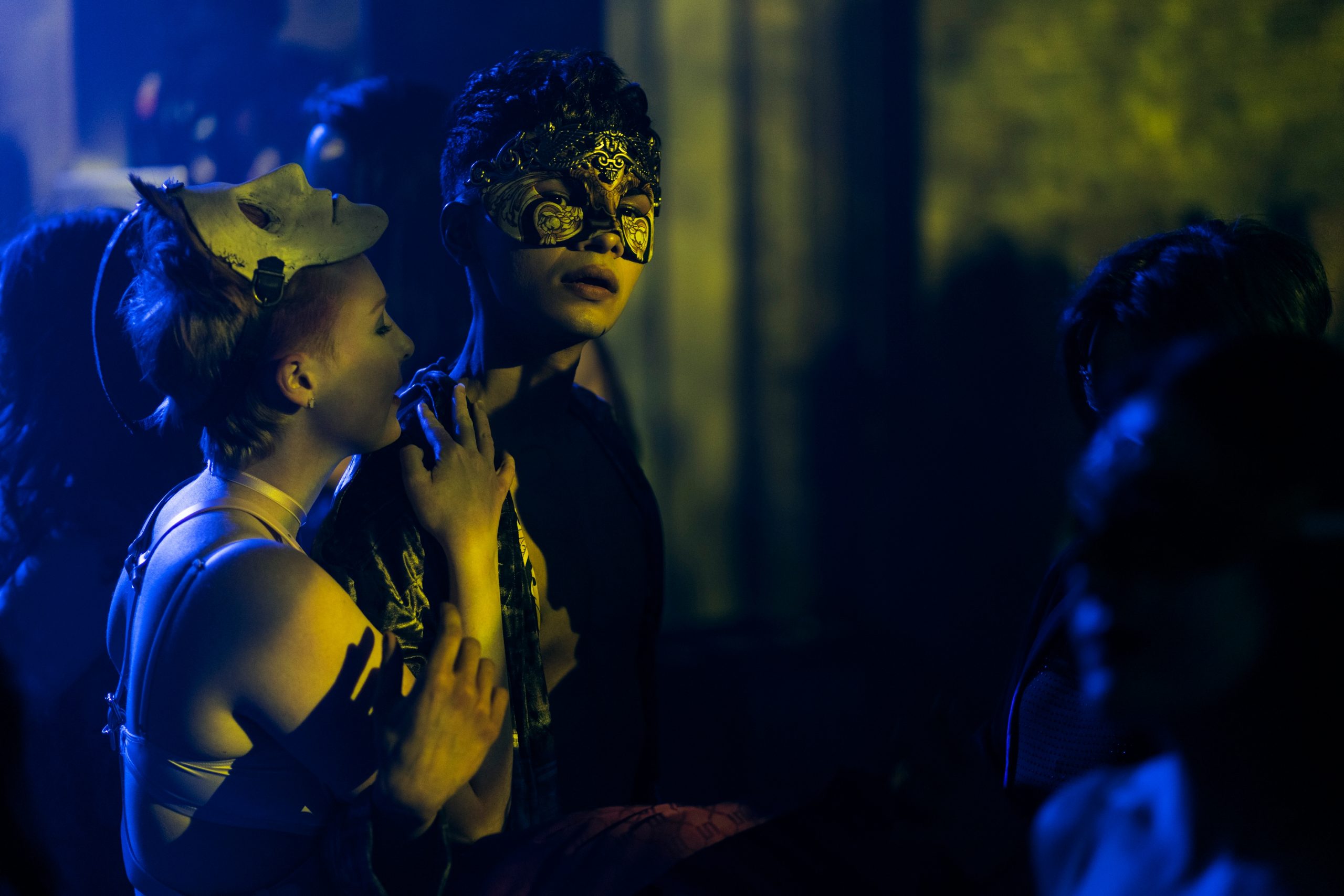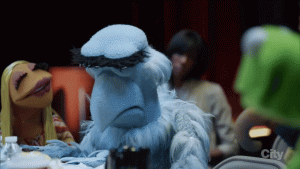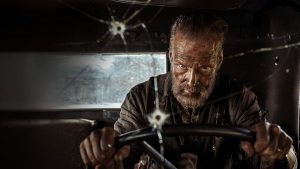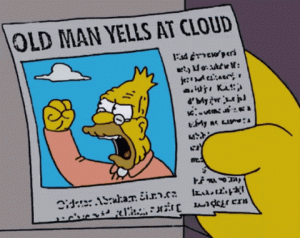
This post contains spoilers for The Fall of the House of Usher and other Mike Flanagan works.
Acid raining from the sky, bodies melting into globs of indiscernible flesh, a troubled boy sucking the last bits of breath into his decimated lungs.
These sights and so much more punctuate the climax to the second episode of The Fall of the House of Usher, easily the most ghastly death in a series full of unsettling ends. Any horror filmmaker would be happy to craft such an upsetting scene, but that’s not all that Usher creator Mike Flanagan can do.
Just moments before young Prospero Usher (Sauriyan Sapkota) gets liquified, he’s met by Verna (Carla Gugino), a woman who haunts every member of the Usher family. Apropos of the Edgar Allan Poe story that gives the episode its title “The Masque of the Red Death,” Verna arrives at the rave/orgy wearing only skimpy lingerie and a death’s head mask. After catching Prospero’s eye, she meets him in a back room bathed in red, where they discuss morality and consequences.
“There’s still time,” coos Verna after removing her mask. When Prospero asks what she means, Verna responds, “Time to stop this.” Full of chemicals and the arrogance of the ruling class, Prospero laughs off the suggestion, but Verna continues. “Everything has consequences,” she promises.
That speech not only foreshadows the imminent end of Prospero and his revelers but also captures the theme of The Fall of the House of Usher. More terrifying than even the sight of beautiful bodies smearing together into dripping chunks is the thought that our past stays with us, that our decisions matter and may have terrible consequences.
Thanks to that approach, The Fall of the House of Usher continues within the modern horror’s favorite theme, the terror of trauma. But where most entries feel like tiresome bids for respectability, Mike Flanagan does trauma horror right, integrating themes of regret into the structure of his scares, working the two together without using one to prop up the other.
The Fall of the Trauma Horror Genre
The 2022 surprise hit Smile has an irresistible visual hook. Before meeting their doom, victims develop a crooked smile, aggressive and menacing in its insistence on happiness. Director Parker Finn uses this conceit as a metaphor for mental illness, for the demand to put on a happy face and ignore serious turmoil inside.
But instead of trusting the metaphor to do its work, Smile insists upon pounding audiences with its themes. The movie opens with a slow “oner” moving from open pills to a recently dead woman to a young girl standing in the doorway, unable to process what she’s seeing. An electric ring rips the scene and we hard cut to our protagonist Dr. Rose Cotter (Sosie Bacon),
To be sure, trauma is nothing new to horror fiction. The gothic literature of the 19th century, such as Wilkie Collins’s Woman in White or Poe’s oeuvre, treated ghosts as lingering regrets. America’s national sins crept into tales about Indian burial grounds and the unconquerable King Kong. Even the lowbrow slashers of the late ‘70s and ‘80s revealed the failures of white flight, as suburbanites learned their summer camps and mod-con-appointed homes could not keep their children safe.
But with the onset of elevated horror (a maligned, but useful term, as we all know what it means), trauma subtext has become text. Some directors have the skill to pull it off, such as Jennifer Kent in The Babadook, in which a mother’s resentment toward her difficult child manifests in a storybook monster. Jordan Peele grafted racist micro- and macro-agressions onto a mad scientist story for Get Out. Ari Aster’s Hereditary and Midsommar make family conversations as frightening as ritual sacrifice.
But these movies work because they never skimp on the horror when telling stories about trauma. It’s not just the skills of Daniel Kaluuya and Bradley Whitford that make moments such as Dean Armitage admiring Barack Obama feel wry and well-observed. It is the visuals of the sunken place, the look of helplessness on Kaluuya’s face as Chris loses autonomy of his body, that depicts the effects of systemic racism. It is a scary image that makes a psychological point, with both aspects supporting instead of overtaking one another.
Too many modern horror movies use trauma as a shortcut to quality. To be sure, some of the greatest horror fiction of all time comes from limited budgets, talents, or lack of taste. From X: The Man With the X-Ray Eyes to The Texas Chainsaw Massacre to Friday the 13th to Saw, necessity has been the demonic mother of invention.
Movies such as Lights Out, Speak No Evil, and Smile treat the scares as secondary to making a (usually not very interesting) point. Take the aforementioned scene in Smile. Finn shoots the oner with total control, moving the camera gracefully along the key elements of the room. It’s handsomely lit and well-framed, supported by Cristóbal Tapia de Veer’s unsettling score. Even the jump scare with the ringing phone startles us.
But what’s the point? These techniques use the language of horror to tell us that Rose still hasn’t processed her mother’s suicide. The movie only gets more obvious from there, from the most simplistic depiction of intrusive thoughts to a literal battle with a monster who should be wearing a sign that says “I am your unresolved mommy issues.” Not only does this approach fail to say anything worthwhile about mental illness, but it cheapens the scares.
Trauma horror storms into a dark room and throws on the light, revealing the ghosts that terrified us to be nothing more than nondescript people in well-washed sheets.
The Haunting of Trauma Horror Done Right
Late in Flanagan’s first Netflix series, The Haunting of Hill House, Crain sisters Shirley (Elizabeth Reaser) and Theo (Kate Siegel) squabble during a car ride. Shirley wants to know why Theo tried to seduce her husband and stays steadfastly on the subject. Theo tries to explain an incident from childhood, when she was locked in a dark room in Hill House and lost sight of her father.
“I needed… I needed…” Theo stumbles, trying to explain. “I couldn’t see him, if that makes any sense.”
Theo’s tearful attempts at vulnerability do not dissuade Shirley, who hardens her brow and tries to drop the subject.
“You just don’t know what I’m dealing with,” Theo continues, but Shirley isn’t having it. “We’ve all been dealing,” she barks. “And we somehow managed not to fuck each other’s spouses.”
The argument roars louder, with each sister willfully misreading the other. Suddenly, a ghostly visage juts from the backseat and roars, her scream distorting on the soundtrack.
This jump scare works to upset House viewers, but not just because a loud noise startles us. It works because Flanagan integrates the scare into the conversation and into the series’ overall themes. The ghost is their younger sister Nell (Victoria Pedretti), whose suicide in Hill House forces the family to recall their mother’s suicide and their father’s odd behavior. By the end of the series, we realize that Nell’s hauntings, including the scream in the jump scare, stem from her desire for her family to heal, to put to rest the hurt between them and to care for one another.
Still, Nell’s interruption is a jump scare, one of the most reliable tools of a horror filmmaker, so effective that many dismiss it. Like John Carpenter or Wes Craven before him, Flanagan knows how to craft the jump scare for maximum effect, using overlapping dialogue to make viewers listen more closely and establishing a visual rhythm of cutting between the sisters, only to break it all with Nell’s scream.
Flanagan approaches all his scares to meld theme and form. Flanagan holds his camera as a young boy (Jacob Tremblay) gets tortured to death by a vampiric cult in Doctor Sleep, his child-like pleas mixing with their ecstatic moans. In 2014’s Oculus, Kaylie munches on an apple while putting lightbulbs in a house that houses a haunted mirror, only to realize that she’s eating a lightbulb when blood pours from her mouth.
At the end of the fifth episode of Flanagan’s masterpiece Midnight Mass, the recently-turned vampire Riley Flynn (Zach Gilfrod) rows his friend and possible victim Erin (Siegal) far from the shore. The scene builds upon our fear for Erin until Zach reveals that he rowed them out there so that he couldn’t run away, revealing to her the vampire threat and encouraging her to save the town.
As the sun rises and he finishes his speech, Riley sees in front of him not Erin, but the young woman he killed in a drunk driving incident, whose death filled him with regret. But no sooner do we viewers acclimate to the peaceful piano, the warm orange sun, the soft rocking of the waves, than Flanagan hard cuts to Erin’s shrieking face, watching in terror as Riley incinerates before her.
Each and every one of these scares involves trauma in some way. But they remain scares that work out of context and grow more rich and chilling within context.
Doctor Trauma
In addition to his approach to the craft of horror trauma, Flanagan also stands out for the way that he perceives trauma. The horrible things that happen to people can haunt and hurt them, but they are never an end to themselves. His victims have opportunities for repentance and ways to show grace to one another, even within their hurt.
Before Prospero gets showered in toxic acid in The Fall of the House of Usher, Verna tells him, “There’s still time […] to stop this.” Peter Quint (Oliver Jackson-Cohen), the resentful executive assistant in The Haunting of Bly Manor is warned repeatedly to stop stealing from his employer before he gets dragged away by the Lady of the Lake (Daniela Dib).
That approach is most obvious in Doctor Sleep, a miracle film that somehow manages to be both a sequel to Stanley Kubrick’s The Shining and an adaptation to the Stephen King book Doctor Sleep, with which King attempted to undo the perceived wrongs in Kubrick’s film version of his work.
When we meet the adult Dan Torrance (Ewan McGregor) in Doctor Sleep, he’s understandably a wreck, given the fact that his dad Jack is an alcoholic and that he lived through the Overlook Hotel. But when Dan considers taking money from the wallet of an addict and single mother he slept with, Dick Hallorann (Carl Lumbly) appears to give him a reproachful, “Doc…” Even after getting clean and finding a stable life as a hospice orderly, where he uses his shine to help people die peacefully, Dan goes back to the Overlook to save a girl (Kyliegh Curran) with similar abilities from the True Knot’s voracious leader Rose the Hat (Rebecca Ferguson).
Dan’s trauma hurts him. It costs him most of his adult existence and cuts his life short. The same is true of every character in Flanagan’s filmography, including Prospero and the other members of the Usher family.
But Flanagan does justice to these pains by never letting them become excuses for horrible behavior or replacements for horror scenes. Instead, he integrates them into the whole human experience, making his work richer and scarier than those of almost any other horror filmmaker today.
All eight episodes of The Fall of the House of Usher are available to stream on Netflix now.
The post The Fall of the House of Usher’s Mike Flanagan Does Trauma Horror Right appeared first on Den of Geek.








